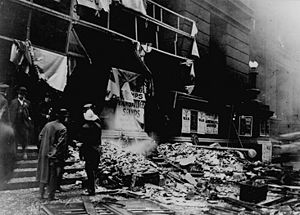Industrial Workers of the World
The 1909 strike against the Pressed Steel Car Company of McKees Rocks, Pennsylvania, attracted the attention of the IWW, which had a policy of "an eye for an eye, a tooth for a tooth, blood for blood."[4] According to Thomas Brewton, a staff writer for the New Media Alliance, "The IWW delivered on that threat by murdering half a dozen members of the state constabulary."[5] Among those killed were Pennsylvania State Troopers John L. Williams and John Curtis Smith.[6]
The IWW never had a large following, making its greatest impact when it seized control of a large textile strike in Lawrence, Massachusetts in 1912. The AFL unions greatly outnumbered the small IWW contingent in Lawrence, but dramatic actions gave momentum to the IWW, much to the disgust of regular unionists. John Golden, president of the AFL United Textile Workers denounced the IWW action as "revolutionary" and "anarchistic" but failed to wrest the leadership of the strike away from the Wobblies. AFL President Samuel Gompers denounced the strike as a "class conscious industrial revolution ... a passing event that is not intended to be an organization for the protection of the immediate rights or promotion of the near future interests of the workers." Radical historians have celebrated the strike. When the state government sent in the militia, the IWW sent in its top firebrands, Haywood, Italian anarchist Carlo Tresca, and his wife Elizabeth Gurley Flynn. Finally, the strikers won a small pay increase. IWW membership swelled to 10,000, but the union proved unable to bargain on a routine basis for its members.
The IWW is most famous for the execution of IWW member Joe Hill. As Brewton recounts:
| “ | In 1914 Salt Lake City former policeman John Morrison and his son Arling were shot dead by gunmen as they were closing their small grocery store for the night. Before being shot to death, Arling managed to fire the store’s pistol at the intruders.
A younger son, who was in the rear of the store when the gunmen burst into the store, heard one of them shout, “We’ve got you now.” It was noted in the subsequent trial that Morrison had quit the police force because of threats from IWW members whose activities he had confronted while enforcing the law. An hour and a half after the murders, Dr. Frank McHugh was awakened at his home by IWW member Joe Hill, who had a gunshot wound in his chest. As he was being treated, a revolver slipped from his pocket to the floor. Hearing about the Morrison murders the next day, Dr. McHugh alerted the police. Joe Hill was arrested, convicted, and executed for the murders.[7] |
” |
In 1916, in Everett, Washington, IWW members organized a strike in the lumber-shipping port activities. The local sheriff, seeking to disband the strikers in accordance with existing law, ran into the same violent street tactics by armed IWW members that had occurred in McKees Rocks, Pennsylvania. In the armed assault by the IWW a deputy sheriff and a lumber company official were murdered and 24 non-union workers were wounded. Strongest among miners and lumberjacks in the far west, the IWW lost its next big strike, in Patterson, New Jersey, in 1916, and membership fell to 400 radicals.

That year, after the Bolsheviks brutally[10] crushed[11] a wave of strikes,[12] Haywood betrayed the workers, saying, "every genuine labor union in the United States ought to affiliate with the International Council of Trade and Industrial Unions with its central bureau at Moscow."[13] (The ICTIU was the phony "union" created and controlled by the Kremlin to suppress workers' rights in the Soviet Union.)[14] The union collapsed, but a tiny remnant still exists.
The IWW remains an icon of the far left, who admire its bitter, often violent opposition to capitalism and its rejection of American ideals.
Further reading
- Dubofsky, Melvyn. We Shall Be All: A History of the Industrial Workers of the World (abridged ed. 2000) excerpt and text search
External links
References
- ↑ The ABC's of Revolutionary Unionism, Industrial Workers of the World
- ↑ J. Anthony Lukas, Big Trouble: A Murder in a Small Western Town Sets Off a Struggle for the Soul of America (New York: Simon and Schuster, 1998) ISBN 0684846179, p. 236
- ↑ Jamie H. Cockfield, Black Lebeda: The Russian Famine Diary of ARA Kazan District Supervisor J. Rives Childs, 1921-1923 (Mercer University Press, 2006), ISBN 088146015X, p. 91, fn. 50
- ↑ Jerre Mangione and Ben Morreale, [http://books.google.com/books?id=MKzorg2128cC La Storia: Five Centuries of the Italian American Experience (New York: HarperCollins, 1993) ISBN 0060924411, p. 295
- ↑ Thomas E. Brewton, IWW - Organized Crime in the Labor Market, The View From 1776
- ↑ Marylynne Pitz, "Pressed Steel Car strike in McKees Rocks Reaches Centennial Anniversary," Pittsburgh Post-Gazette, August 16, 2009
- ↑ Thomas E. Brewton, IWW - Organized Crime in the Labor Market, The View From 1776
- ↑ IWW Bomb Kills Four in Chicago," The New York Times, September 5, 1918; Charles Howard McCormick, Hopeless Cases: The Hunt for the Red Scare Terrorist Bombers (Lanham, Md.: University Press of America, 2005) ISBN 0761831320, pp. 31-31
- ↑ Douglas Linder (2003), William D. Haywood, Famous Trials (University of Missouri-Kansas City School of Law)
- ↑ Scott Zenkatsu Parker, Pravda o Kronshtadte ("The Truth about Kronstadt"), ed. Mary Huey (University of Michigan)
- ↑ "Bolsheviki Crush Moscow Uprising," The New York Times, March 11, 1921
- ↑ Michael C. Hickey, A Social Contract and No Socialism, H-Russia Discussion Network (April, 2009), H-Net (Humanities and Social Sciences Online), Michigan State University
- ↑ Max Eastman, "Bill Haywood, Communist," The Liberator, April, 1921;
- ↑ Профессиональные союзы СССР (The trade unions of the USSR), cultinfo.ru; cf. Israel Getzler, Kronstadt 1917-1921: The Fate of a Soviet Democracy (Cambridge University Press, 2002) ISBN 0521894425, p. 233
